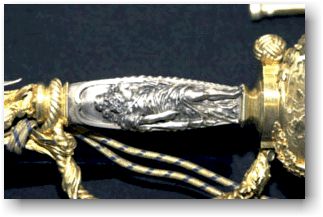
The Case of the Missing Civil War Sword
Piece of History Returned by FBI in Ceremony at U.S. Naval
Academy
(13 January 2004 – SIRS Government Reporter)
On March 9, 1862,
just three days shy of his 44th birthday, Lieutenant John Lorimer Worden was fighting
the battle of his life. The ship he commanded--the iron-plated USS Monitor--had
just arrived in the waters outside Hampton Roads, Virginia. Its mission: to
turn back another armored vessel, the CSS Virginia (often known by its previous
name, the Merrimack), which had sunk two Union frigates the day before and was
threatening the North's naval blockade.
Shortly after
 noon, following hours of heavy volleys back and forth, the Virginia aimed its
fire at the pilothouse of the Monitor, where Worden was directing the fight. A
shell exploded, temporarily blinding the Lieutenant. His injuries were so
severe that he had to relinquish command. But the Monitor kept fighting,
forcing the Virginia to withdraw and preserving the blockade, the Union fleet, and
ultimately, the Union itself.
noon, following hours of heavy volleys back and forth, the Virginia aimed its
fire at the pilothouse of the Monitor, where Worden was directing the fight. A
shell exploded, temporarily blinding the Lieutenant. His injuries were so
severe that he had to relinquish command. But the Monitor kept fighting,
forcing the Virginia to withdraw and preserving the blockade, the Union fleet, and
ultimately, the Union itself.
An Elegant
Tribute. News of the world's first ironclad battle spread quickly,
electrifying the nation and forever changing the history of naval warfare. It
also made John Worden a hero. President Lincoln himself visited the injured
lieutenant. Worden's home state of New York paid tribute to its native son as
well--in a grand way. It commissioned from Tiffany & Co. an ornate, finely
crafted 37-inch sword, inlaid with gold and silver. Its handle was emblazoned
with the Roman God of the Sea, Neptune. And with it came a gold-plated sheath
and gold-embroidered belt. All together, the set cost some $550, a hefty sum in
those days.
The Theft.
Worden's star continued to rise. He served as Superintendent of the U.S. Naval
Academy and ended his career as Rear Admiral. Fifteen years after his death in
1912, the family donated the sword and other items to the U.S. Naval Academy
museum. Then in 1931, the sword--already considered priceless because of its
link to the infamous ironclad battle--vanished. The Navy's investigation came
to nought.
How was
the Sword Found? In 1998, FBI art theft experts in Philadelphia began
investigating the shady dealings of several appraisers on the hit PBS series,
the Antiques Roadshow. By 2002, three men were in jail for engaging in more
than $1 million worth of memorabilia fraud. But FBI Agents didn't stop there. They
pored over the voluminous records of the appraisers, file-by-file, looking for
more stolen treasures or phony deals. Late last year, they found records on the
Worden sword, which had been bought by an appraiser and then resold to a
collector. The Agents contacted the U.S. Naval Academy, discovered the sword
was stolen, and tracked it down. On Monday, the sword was returned to the Naval
Academy in Annapolis by the FBI.
The FBI's
Advice For Collectors:
Two words: due diligence. When buying a priceless work of art, make sure you
know its history. It is a federal offense to obtain by theft or fraud any
object of cultural heritage from a museum. For more information, see the FBI's
Art Theft website.
